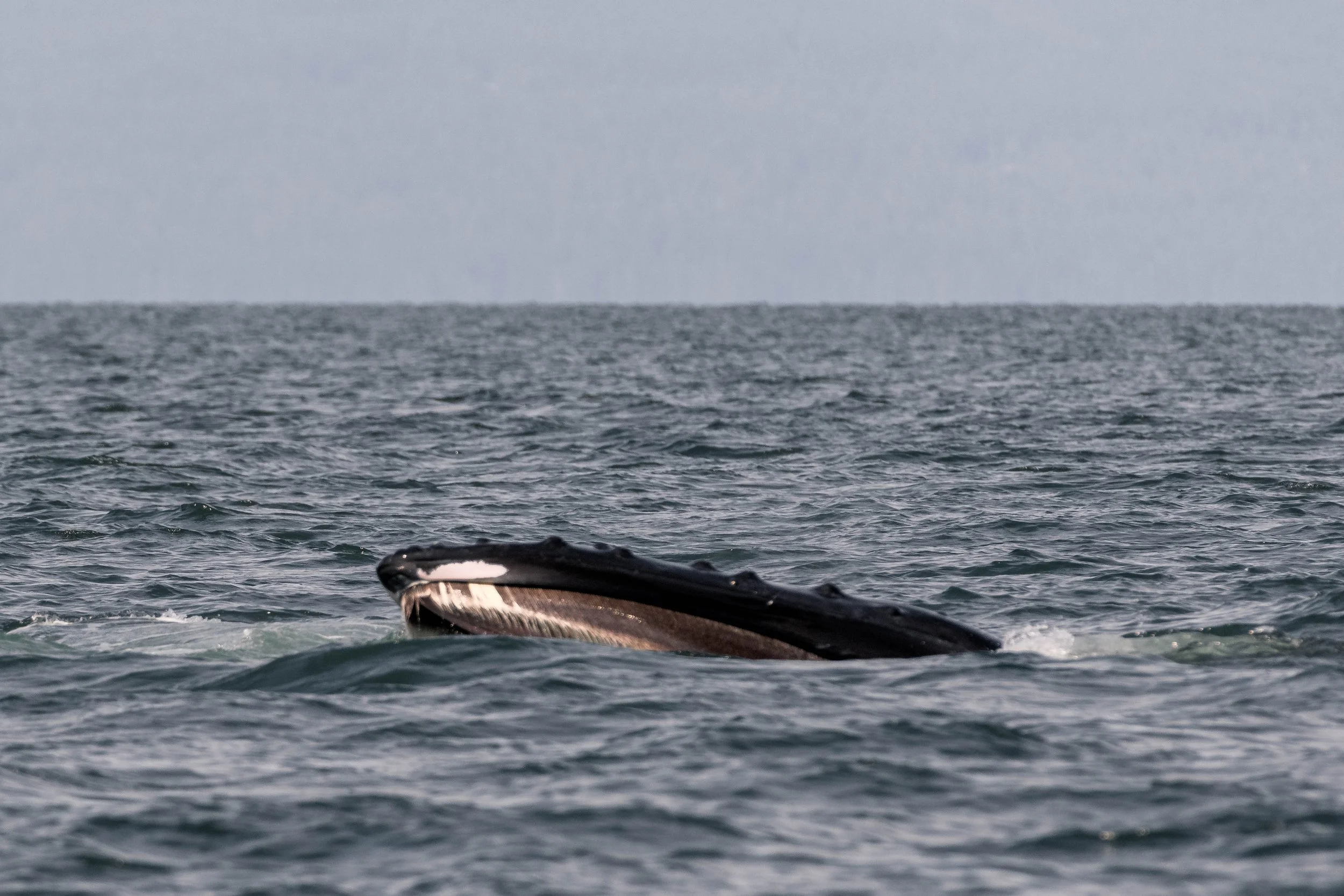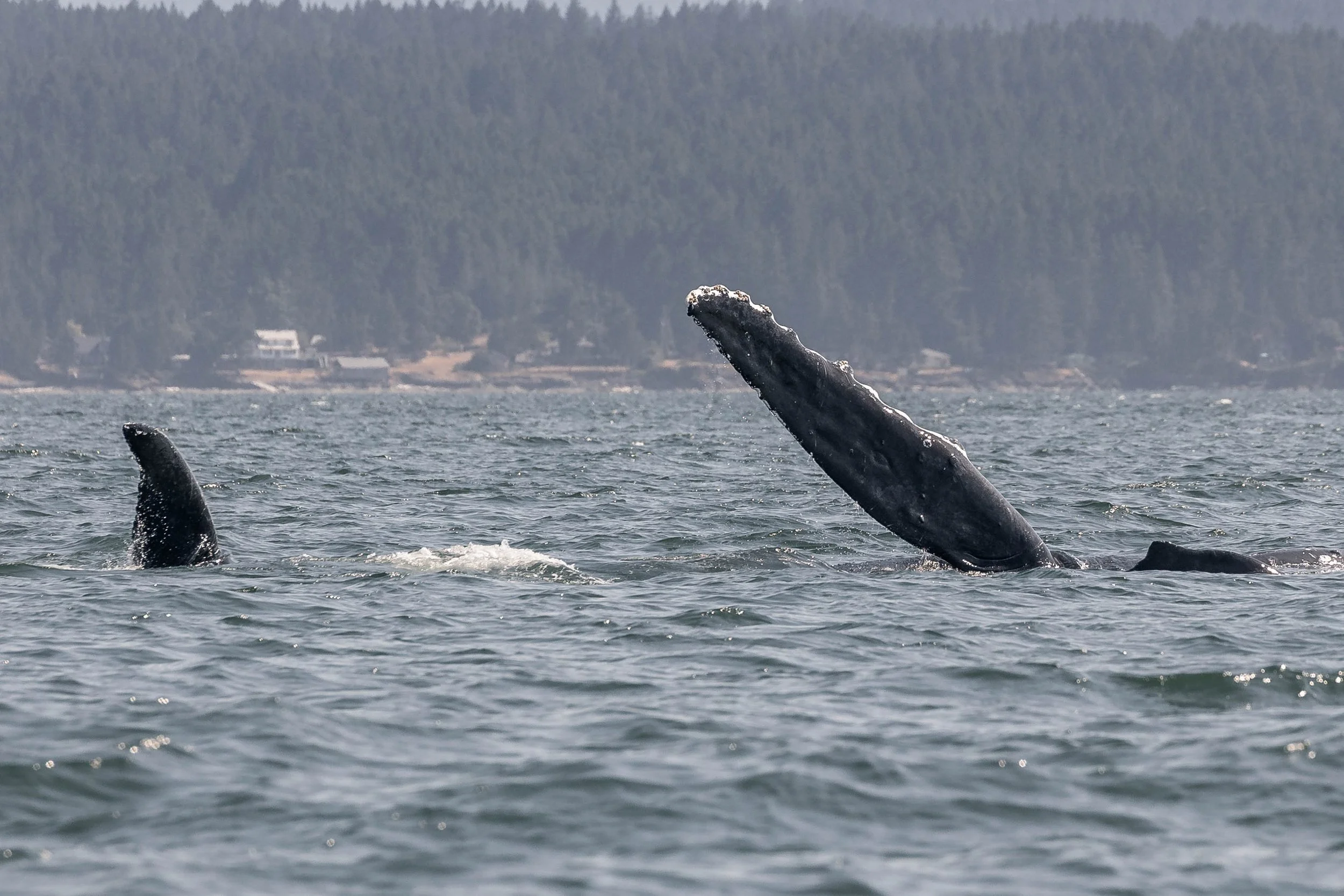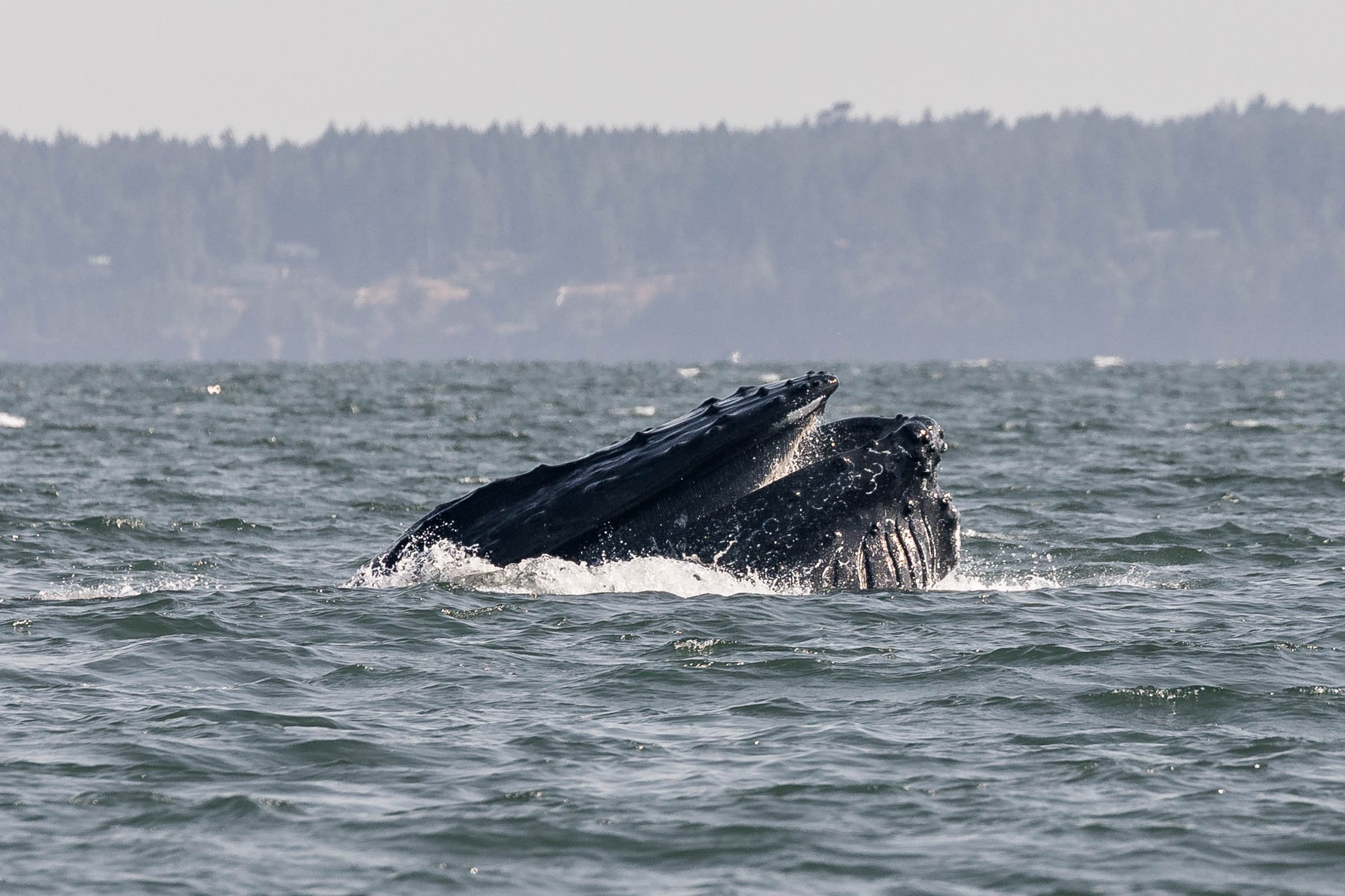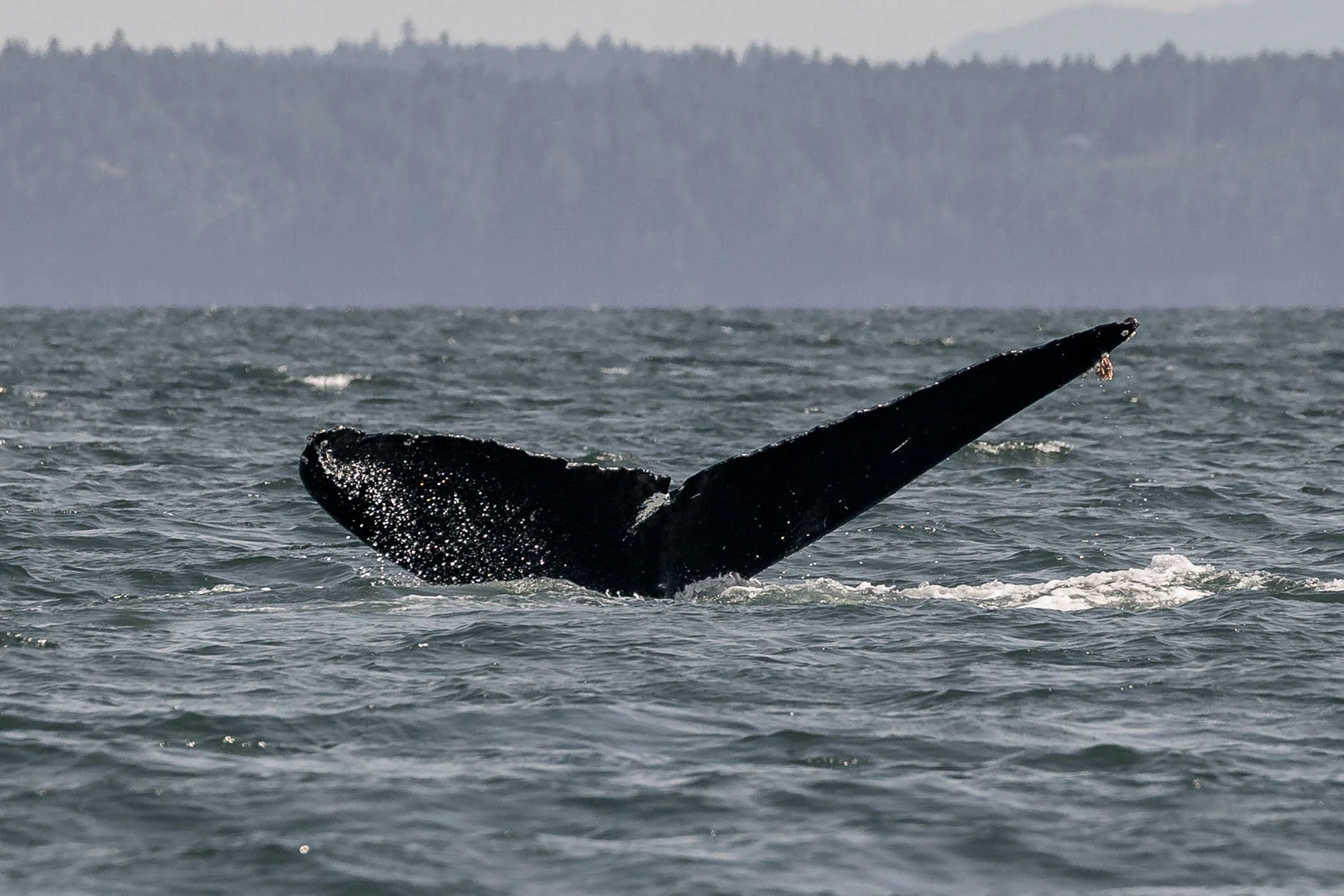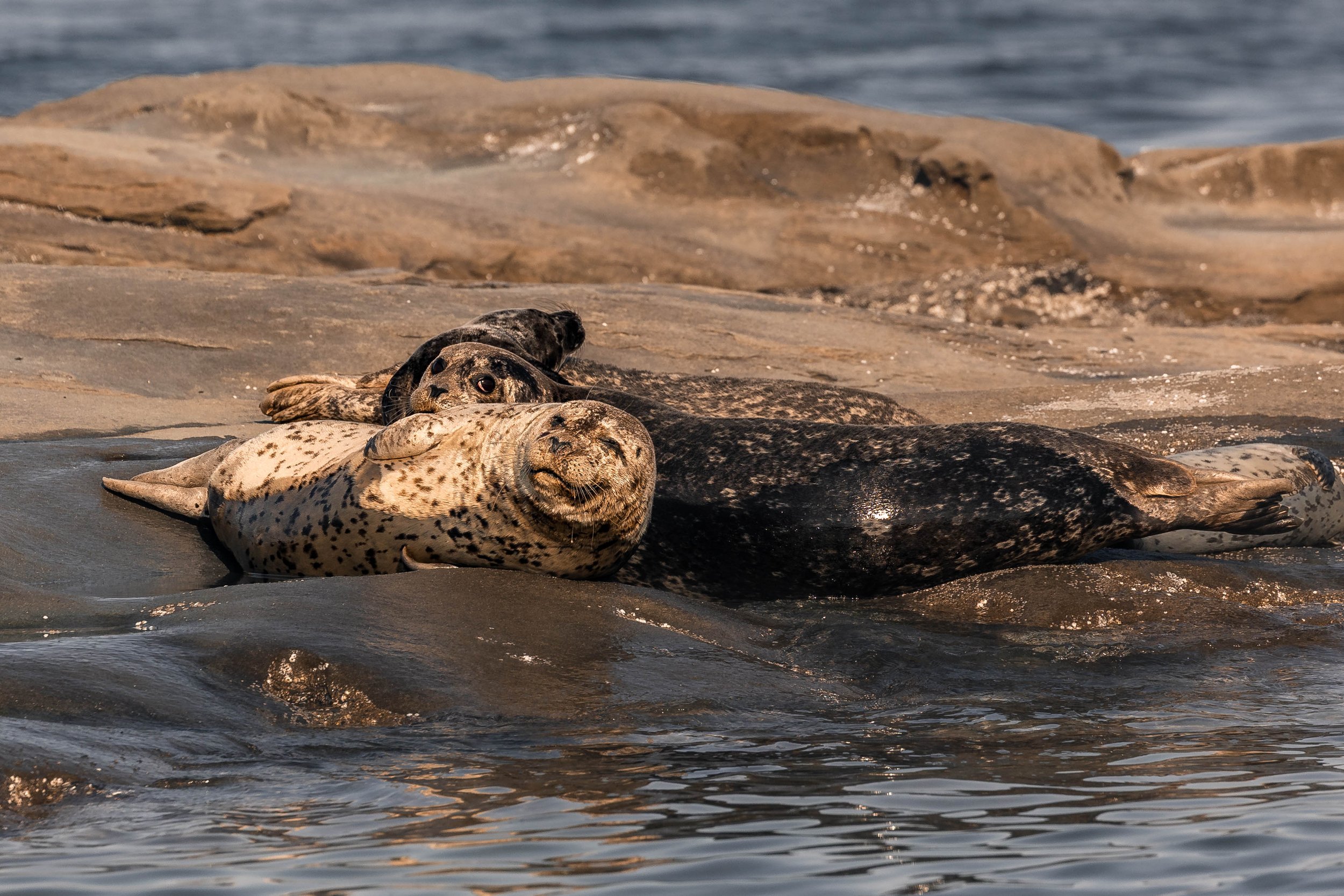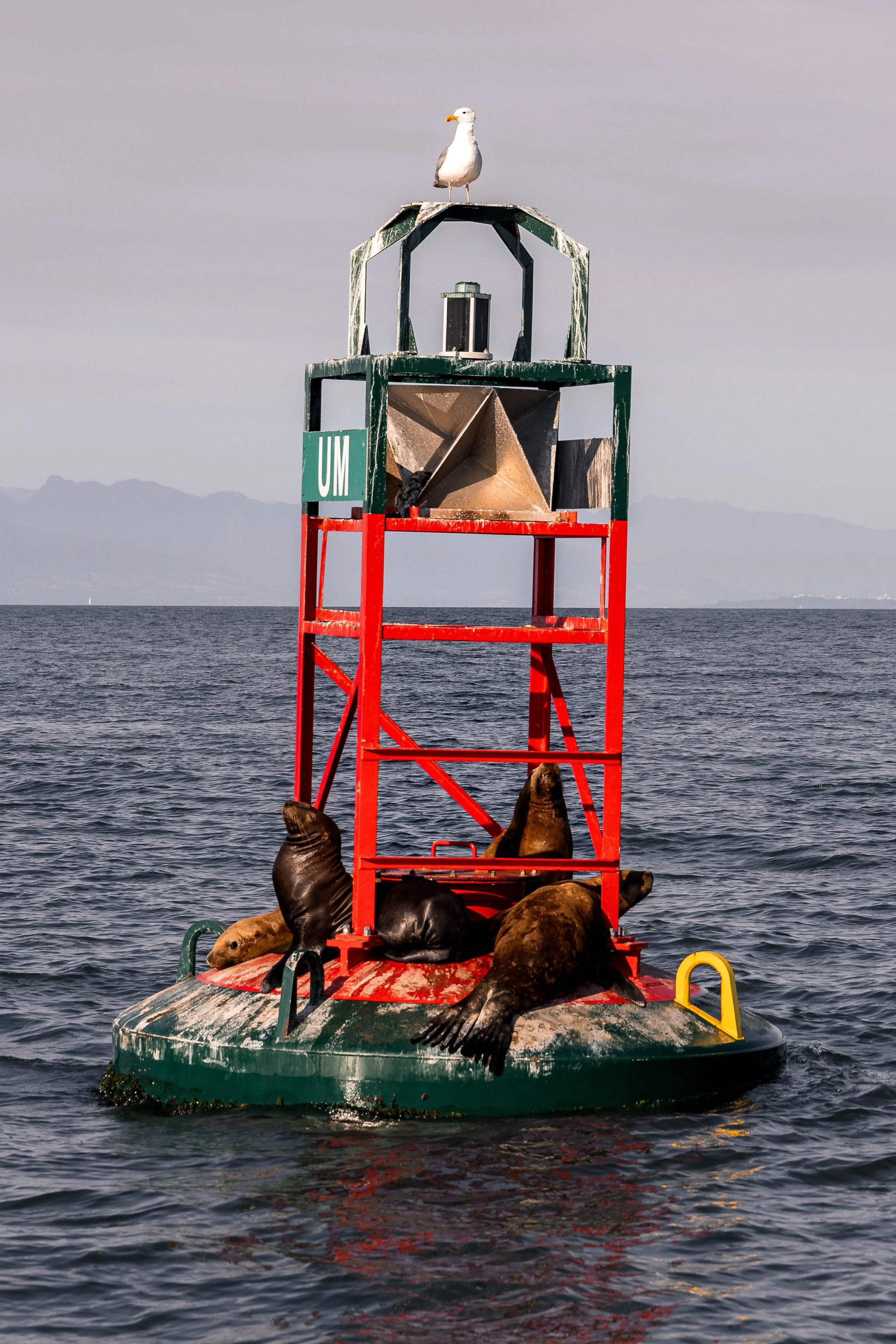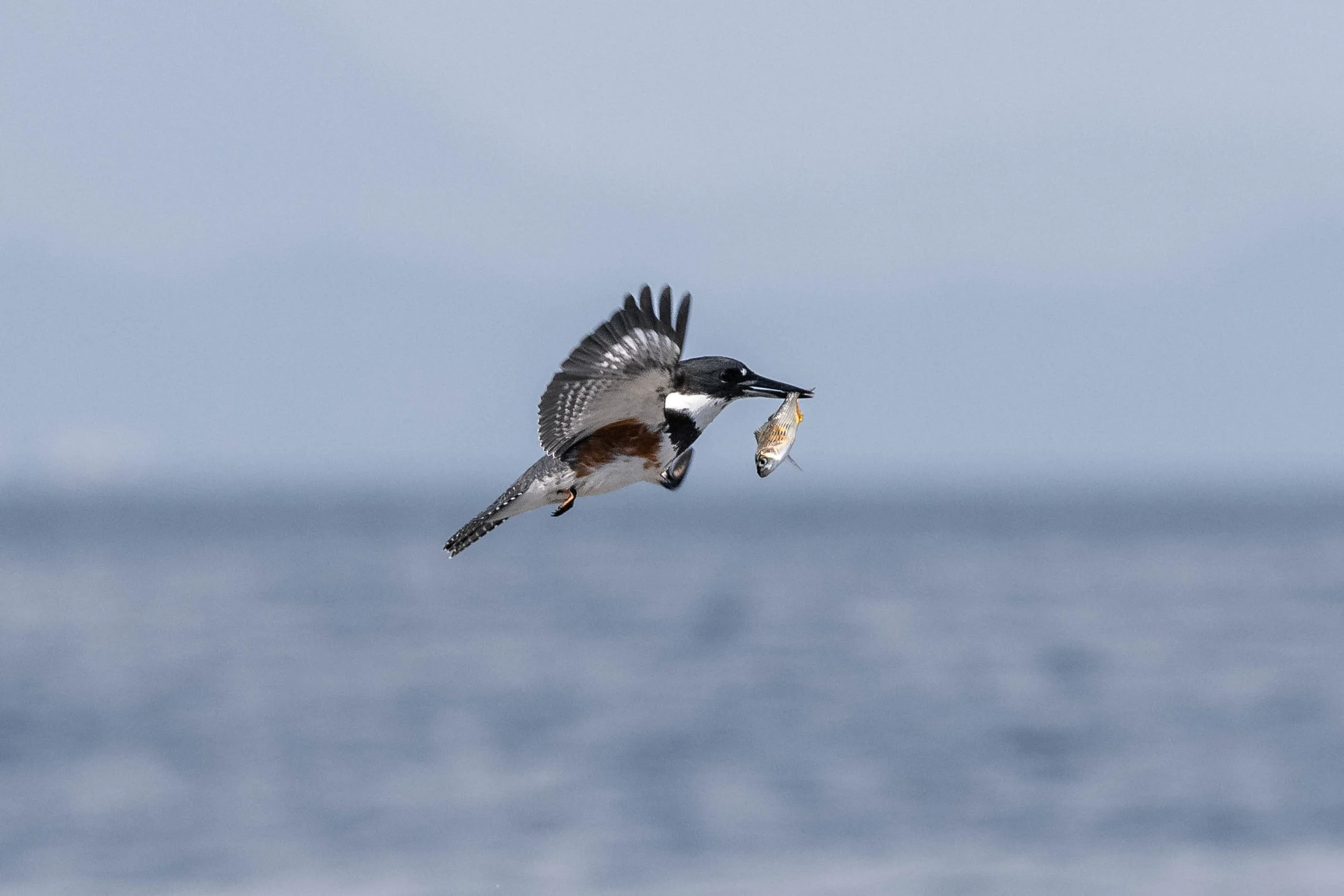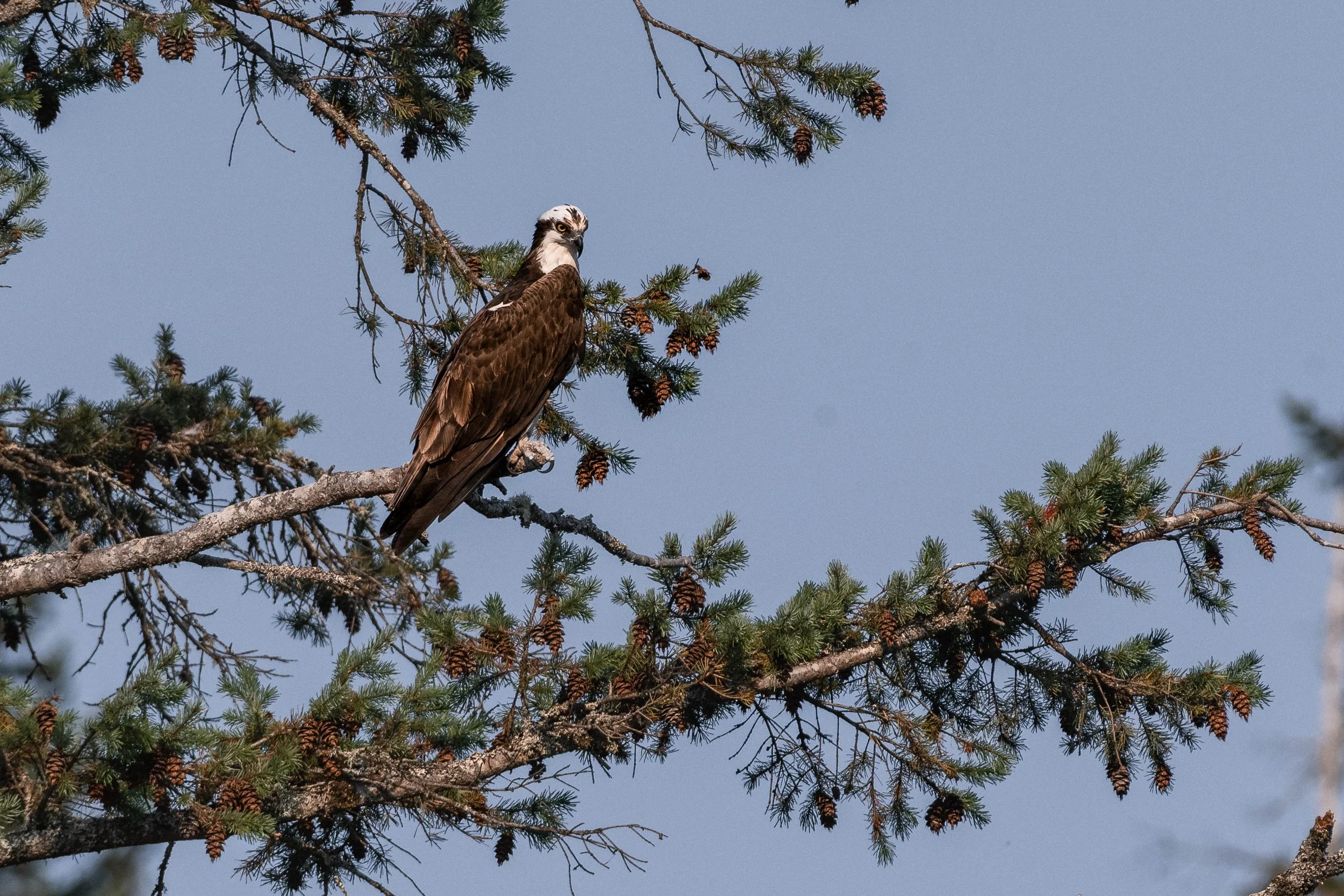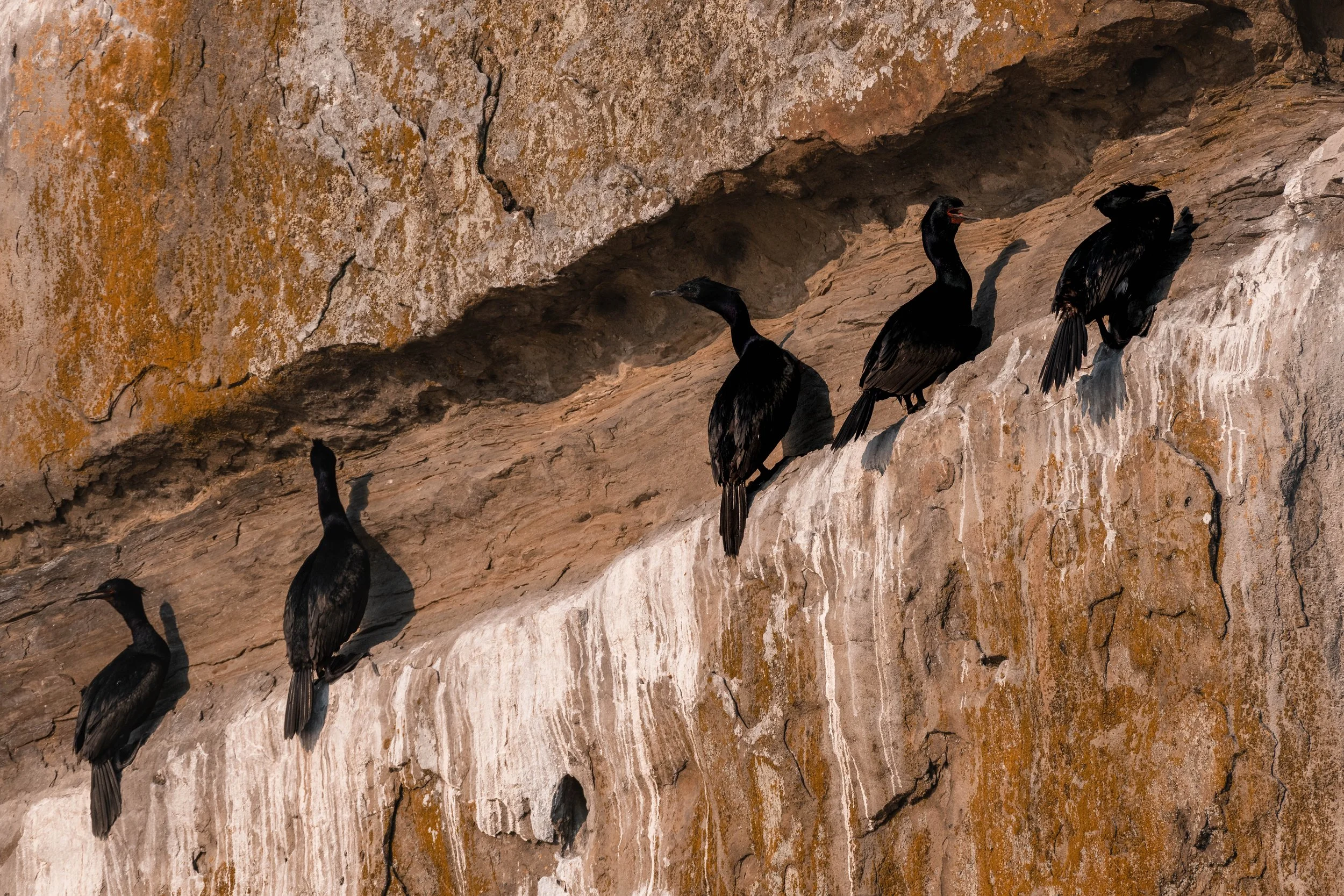August 1, 2025, 3:30 PM - Eleven whales in an Evening!
August is here, which means we are finally in the ultimate month for humpback sightings - and today really showcased that!
As is tradition, our three vessels began venturing in slightly different directions to cover as much ground as possible. We started scanning, and scanning, and very soon after departing from our dock, we located what we were looking for - a couple of big puffs (blows) and some big beautiful tails raising into the air, gracefully arching as they headed down into the depths.
Our open vessels Cascadia and Keta had located a pair travelling side-by-side, and Kula had located a humpback travelling solo.
The onboard naturalists began snapping photos of the whales, and with those photos, they cross-referenced the local humpback whale catalogues to confirm which individuals they were with. Cascadia and Keta had it a bit easier, as their whales were cooperative and fluking high into the air. Their pair was identified as Nike (BCX1377) and Checkmate (BCY1104).
Kula’s individual was a bit trickier, as they were being fluke-shy, but thanks to how unique their dorsal fin is, we were able to identify them as Bullet (BCX1658). As Bullet was seemingly travelling along and not fluking as we observed her, Kula decided to part with them and make their way over to the pair that had been spotted by the open boats.
At first, Nike and Checkmate were travelling along in very typical humpback fashion. During the summer months, our humpbacks are busily packing on the pounds and feasting on as much krill as they can get in preparation for the upcoming breeding season. Checkmate appeared to become excited, though, as they began to cartwheel. Cartwheeling is one of the many acrobatic displays humpbacks may do when you are observing them. It involves the whale throwing its rear half out of the water in an arc, a beautiful display that ends with a big splash as they re-enter the water! Besides cartwheeling, these two were also observed lunge-feeding at the surface (snapping their mouth shut and trapping prey inside) and pectoral slapping at the surface. While we do not know for sure why these animals do these behaviours, it is generally believed they may happen as a form of play, parasite removal, warning of danger, or an invitation to come over and join them for a meal!
After the surface-happy duo had burnt some energy, they began fluking and travelling again, and shortly after, left each other’s sides. When this occurred, our fleet also departed, once again on the lookout for more whales. Once again, the boats headed off in separate directions, which resulted in all three of them finding their separate whales!
Keta was the first boat to find more humpbacks. This time, it was another pair travelling, fluking, and also lungefeeding! These two were identified as Niagara (BCY0057) and Apollo (BCY0862). Niagara and Apollo are both regulars to the Salish Sea, returning year after year. Apollo is also a first-time grandmother this year, with her calf Nova (who we saw just a few days ago!) returning to our area with her first calf in tow!
While Keta was with Niagara and Apollo, Cascadia was with a separate pair of humpbacks identified as Smoke (BCX2183) and Malachite (BCY1463). These two youngsters are also regulars to our area. Interestingly, Smoke’s natal feeding grounds is actually up in Alaska - this has been confirmed through their Happywhale sightings. After they experienced a severe accident in 2021, leading to significant damage to their fluke and peduncle, Smoke ended up staying in our area for the summer, and they have now returned here ever since! While this is not the usual, as humpbacks typically return to the areas their mothers teach them to eat in, it is a great example of the adaptability of the humpback species to overcome hardships and flourish and survive.
Kula located a pair of humpbacks (are we seeing a trend here?) while the open boats were observing their humpback pairs - but theirs was a bit different. As they watched, they noticed one whale was significantly smaller than the other - that’s because this pair was actually a mother and calf! They appeared quite sleepy and were not being very surface active as we watched, but thanks to the mother’s unique dorsal fin, we identified them as Kappa (BCX0158) and a 2025 calf. This calf will continue to travel by Kappa’s side for a few more months, but by this time next year, they will be off exploring the ocean solo, facing the trials and turbulence of the unknown, and hopefully returning to our seas by next summer!
After Keta departed Niagara and Apollo, they thought they had found all the whales they would for the day… until they stumbled on yet ANOTHER pair of humpbacks! This time it was Professor X (BCX1965) and Vanta (BCX1730) who appeared to be napping as they observed them. Humpbacks never have a “full night's rest” like humans do. Instead, they experience something known as unihemispherical sleep, where they ‘turn off’ half of their brain at a time. When they do this, the other half of their brain is in charge of lifting their bodies to the surface of the water to breathe, before sinking back down into the depths a few feet. Just like us, humpbacks require air to breathe, and interestingly, they are manual breathers, meaning they have to think about every breath they take in their life, unlike humans, who do it automatically!
At this point, all our vessels departed from their whales and started searching for some other wildlife. This time, they were looking for pinnipeds, or fin-footed mammals such as seals and sea lions. We have several different haulouts where they can be seen, and today we stopped at two different ones! Kula headed over to the UM buoy outside of Gabriola Pass, where a couple of Steller Sea Lions were snoozing away. Cascadia and Keta went to the lovingly-dubbed “Stinky Rocks” where the Steller Sea Lions were meandering over each other to get to the best sunning spots on the rocks. Nearby, there were also a couple of Harbour Seals balancing elegantly up on the rocks, not a care in the world, as they took in the setting sun. While here, a Belted Kingfisher also decided to grab a quick snack, diving into the shallows and snapping up a fish right before our eyes!
Once we left the pinnipeds behind, we headed through the islands and back towards home port. The wildlife encounters didn’t stop there, though, as there was an Osprey nestled up in the trees to see! After crossing Dodd Narrows, a tiny waterway outside Nanaimo’s harbour, there was one final stop at the Gabriola Bluffs to see a Bald Eagle roosting high up on the cliffs, a gulp of Cormorants nestling in for the night, and a handful of Gulls (and chicks!) waddling into one of the rock crevices!
Please enjoy these photos by Marine Naturalists Hayleigh Hilbert, Aly Kohlman, and Jordan Robinson!
Half of Nike’s fluke as he travels on his side. Photo by Aly Kohlman.
You can view a bit of the baleen plate from this angle! Photo by Aly Kohlman.
Checkmate waving their fluke around. Photo by Aly Kohlman.
Checkmate’s fluke has many scratches and scrapes we can use to identify them. Photo by Aly Kohlman.
Checkmate’s fluke. Photo by Aly Kohlman.
Malachite’s dorsal fin. Photo by Aly Kohlman.
Malachite’s blowholes and some of his tubercles! Photo by Aly Kohlman.
Smoke beginning to dive. Photo by Aly Kohlman.
Checkmate’s dorsal fin. Photo by Hayleigh Hilbert.
Checkmate cartwheeling with Nike right beside them. Photo by Hayleigh Hilbert.
Checkmate travelling on their side, pec up in the air, with Nike beside them. Photo by Hayleigh Hilbert.
Baleen plates visible as they lungefeed at the surface, their mouth open wide and ventral pleats expanding. Photo by Hayleigh Hilbert.
Snapping shut! Photo by Hayleigh Hilbert.
Niagara’s fluke. Photo by Hayleigh Hilbert.
Apollo’s fluke. Photo by Hayleigh Hilbert.
Professor X’s dorsal fin. Photo by Hayleigh Hilbert.
Vanta’s fluke. Photo by Hayleigh Hilbert.
Kappa (left) and her 225 calf (right). Photo by Jordan Robinson.
Kappa’s calf beginning to arch their back with Kappa’s fluke up in the air. Photo by Jordan Robinson.
Kappa’s calf’s fluke! Photo by Jordan Robinson.
Peeking over their ‘pillow’ - AKA another Harbour Seal! Photo by Hayleigh Hilbert.
A carefully balanced Harbour Seal. Photo by Aly Kohlman.
Snoozing on the buoy. Photo by Jordan Robinson.
The UM buoy is sometimes a hangout spot for our Steller Sea Lions. Photo by Jordan Robinson.
Steller Sea Lions gathered at Stinky Rocks. Photo by Aly Kohlman.
A Belted Kingfisher after a successful fishing adventure. Photo by Aly Kohlman.
Osprey perched high up in the trees. Photo by Aly Kohlman.
A beautiful Osprey glowing in the sun. Photo by Aly Kohlman.
A Bald Eagle fluffed up in the trees, with an Arbutus behind them. Photo by Aly Kohlman.
Cormorants clinging to the Gabriola Bluff cliffs. Photo by Aly Kohlman.
Can you spot the baby Gulls in this photo? Photo by Aly Kohlman.
Dodd Narrows. Photo by Jordan Robinson.


